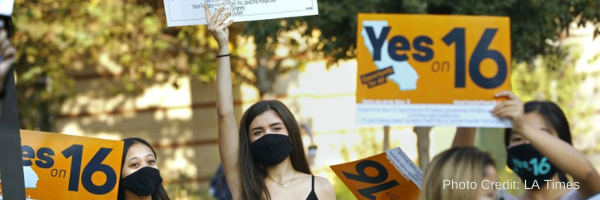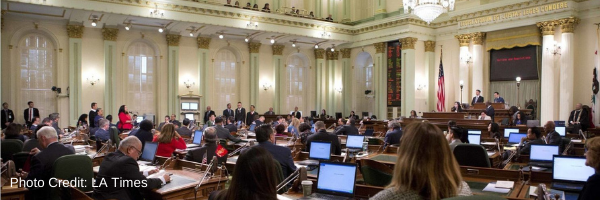In this Issue:
- Federal Election Outcomes: A Preliminary Analysis
- California Election Results: What We Know So Far
- Propositions 15 and 16 Fail to Pass
- Contact Your Elected Representatives
- Fall Recess Talking Points and the League’s Annual Legislative Conference
- Federal Grant Opportunities
- Upcoming Events
Federal Election Outcomes: A Preliminary Analysis
Over the weekend, Joe Biden was named the President-Elect and has now secured 290 votes from the Electoral College. Biden will become the 46th U.S. President and the oldest man ever sworn into the office, and Senator Kamala Harris will be the first woman and first woman of color to serve as the U.S. Vice President. At the time of this writing, it appears the U.S. House of Representatives will retain its Democratic majority despite losing seats, while the U.S. Senate will remain in Republican control. These remain predictions, as not all votes have been counted. What is not in question is that both COVID and the ensuing recession remain extremely consequential and will be at the forefront of the national consciousness for the foreseeable future.
Beyond the outcome of the election, the immediate concern of the League is on whether the House and Senate will resume negotiations on a stimulus package and what that might entail. In this regard, the League has pressed Congress on two issues:
- For additional federal resources for higher education to be distributed on a per-student, compared to a Full-Time Equivalent Student (FTES), basis; and,
- For any relief package to include assistance to the states.
These objectives are based on the need to count all our community college students, the majority of whom are part-time, and to allow California sufficient resources to partially buy down the deferrals for community colleges in this year’s Budget Act. One question that has already been raised is whether Speaker Pelosi will defer negotiations on a relief package until January or attempt to strike a deal now.
There is also speculation in Washington, D.C., on who will succeed retiring Senator Lamar Alexander (R-TN) as Chair of the Health, Education, Labor, and Pension Committee. According to David Baime of the American Association of Community Colleges, Susan Collins (R-ME) has a strong chance with Rand Paul (R-KY) and Richard Burr (R-NC) as possibilities. For California seats in the U.S. House of Representatives, Republicans look to have picked up a number of races including:
- Outgoing Republican Assemblymember Jay Obernolte is likely to succeed retiring Republican Congressional Representative Paul Cook;
- Former Republican Congressional Representative David Valadao is likely to unseat incumbent Democratic Congressional Representative TJ Cox;
- Democratic Assemblymember Christy Smith is in a close race against Republican Mike Garcia;
- Republican Young Kim is narrowly prevailing over incumbent Democratic Congressional Member Gil Cisneros;
- Republican Michelle Steel has a narrow lead over incumbent Democratic Congressional Representative Harley Rouda;
- Former Republican Congressional Representative Darrell Issa is likely to prevail against Democrat Ammar Campa-Najjar; and
- Democrat Sara Jacobs has defeated Democrat Georgette Gómez.
Governor Newsom has a deep pool of candidates to replace Kamala Harris’ Senate seat now that she is the Vice-President Elect. Some of the possibilities include Secretary of State Alex Padilla, San Francisco Mayor London Breed, Attorney General Xavier Becerra, Los Angeles County Supervisor Hilda Solis, State Senator Maria Elena Durazo, Long Beach Mayor Robert Garcia, and Congressional Representative Karen Bass. Regardless of whom Newsom selects, Harris is not expected to leave the Senate until right before the presidential inauguration.
California Election Results: What We Know So Far
Democrats Maintain Two-Thirds Majority in Both State Assembly and Senate
As returns continue to come in, it appears that the Democrats have maintained their super-majorities in both the State Assembly and Senate, which means Democrats will make up at least two-thirds of the seats in each house. A two-thirds majority matters as it is necessary to vote on measures relating to revenue increases or urgency clauses.
However, it is also essential to understand that many Assembly and Senate Democrats are elected from generally tax-adverse areas. While the League will continue to work with our legislative and advocacy partners to advocate for our districts, an increase in revenues still presents a difficult challenge to overcome.
Assembly Incumbents Fend off Challengers
Perhaps what is most notable for the State Assembly is that neither party saw much change. As of now, there will be roughly 60 Democrats, 19 Republicans, and one independent elected to the State Assembly, with a projected net gain of one additional State Assembly seat for Republicans. Democrats will still hold their substantial majority in the Assembly.
An interesting trend for both Assembly Democrats and Republicans is that incumbents have successfully fended off their challengers from their current or former party. Examples of these incumbents range from Assemblymember Reggie Jones-Sawyer of Los Angeles and the former Republican Minority Leader (and now independent) Chad Mayes of the Inland Empire.
State Senate: Significant Reduction to the Republican Caucus
While votes are still being counted and a few races are too close to call, it is clear that the Senate Republicans will return to Sacramento with smaller numbers than they had before November 3rd. As of the current count, it appears that Democrats will have a net gain of between two and four State Senators. It should be noted that a few State Senate races are very close, and votes are still being counted.
How the Senate will address a significantly smaller Republican caucus is a question that will be addressed as they reconstitute the body. The Senate will need to consider the various committee assignments, the amount of legislative staff Republicans will be able to maintain, and whether a leadership change may be considered. League staff will monitor their actions and will report back on new developments.
Community College Related Measures
Since the voter threshold for general obligation bonds was reduced in 2000, fewer community college-related measures were put on the local ballots. There could be numerous reasons for this, ranging from the failure of Proposition 13 in March to voter fatigue in the era of a global pandemic or the confusing ballot language requirements. Based on election results available as of the drafting of this article, it appears that bond measures for Citrus CCD and Monterey CCD are likely to pass. The bond and parcel tax measures for San Jose will fail despite obtaining a majority of votes. Bond measures need a minimum of 55% of the vote, while parcel taxes need at least two-thirds of the total.
Votes are still being counted, and League staff are hopeful that the numbers for both the bond request and parcel taxes for San Jose–Evergreen CCD will increase. Below are the results of the measures, as of November 6th:
|
Community College District |
Type |
Ask |
Yes Votes |
No Votes |
Total Votes |
Yes |
No |
|
Citrus |
Bond |
$258 Million |
44,292.00 |
34,098.00 |
78,390.00 |
57% |
43% |
|
Monterey |
Bond |
$230 Million |
31,374.00 |
18,479.00 |
49,853.00 |
63% |
37% |
|
San Jose-Evergreen |
Bond |
$855 Million |
120,887.00 |
108,878.00 |
229,765.00 |
53% |
47% |
|
San Jose-Evergreen |
Parcel |
$18/Parcel |
141,549.00 |
89,841.00 |
231,390.00 |
61% |
39% |
Propositions 15 and 16 Fail to Pass
As the ballots began to be tabulated on November 3rd, it became evident that both Propositions 15 and 16 were failing to garner enough votes to pass. While we won't know the final tally until December 11th, when the Secretary of State officially certifies the election results, the proponents of both propositions will be considering their next steps. The League intends to be engaged with all of our partners on ways to address the issues of racial equity and ensuring that our colleges are adequately funded to help our students succeed.
Proposition 15
Proposition 15 would have required commercial properties valued at more than $3 million to be reassessed annually. Under the proposal, residential and agricultural properties would continue the current practice under Proposition 13. The initiative would have generated revenues for local governments, K-12 districts, and community colleges and, when fully implemented by 2025, was estimated to generate somewhere between $8 to $12 billion a year.
Polling showed that the proposition enjoyed early support, but as opposition began to organize, the initiative declined below 50%. As the vote stands now, the ballot measure currently only has 48.3% in favor and 51.7% opposed. It struggled to win support in most of the state, only succeeding in counties along the northern coast of California plus Los Angeles, Alpine, and Imperial counties.
The campaign for Proposition 15 has not given up hope that it might succeed as there may be enough outstanding ballots left to change the outcome. Four and one-half million ballots still need to be counted across the state. As of November 6th, it was down by 426,663 votes. The Secretary of State has until December 4, 2020, to report the final results.
Proposition 16
Proposition 16 qualified for the ballot when the Legislature approved Assembly Constitutional Amendment 5 by Assembly Member Shirley Weber on June 24, 2020. That proposal sought to strike down Proposition 209, approved by California voters in 1996, which prohibited consideration of race and gender in public employment, education, and contracting. This dramatically impacted UC and CSU admission policies and faculty hiring at all three of our public higher education institutions.
Earlier this summer, the Public Policy Institute of California (PPIC) released findings on California's perspective on race, whose findings showed that 60% of Californians believed racism was a significant problem in the United States. Additionally, two-thirds of those surveyed supported the Black Lives Matter movement. Yet, polling for Proposition 16 by both the PPIC and Berkeley Institute of Governmental Studies (IGS) showed that California voters were not supporting Proposition 16 with anywhere near the same interest.
In September, PPIC polling showed that Proposition 16 only enjoyed 31% support, with 47% voting opposing, and 22% didn't have an opinion. The Berkeley IGS Poll had the proposition at 33% yes, 41% no, and 26% undecided.
By October, PPIC polling for Proposition 16 revealed 37% in support, 50% no, and 12% didn't know. Berkeley IGS polling had also shown similar progress with 38% supporting, 49 opposing, and 13% not knowing their position.
While the proposition has failed, it received more votes than both polls estimated. As of November 5th, it had 43.9% in favor and 56.1% oppose. It received the most support from the following counties: Alameda, Los Angeles, Marin, San Mateo, San Francisco, and Santa Cruz. (Numbers were updated on Nov. 8)
The Proposition 16 campaign was likely hampered by having a small window from when it was placed on the ballot to the actual election window to educate voters about what it would accomplish. People associated with the campaign have acknowledged that voters may have been confused by the proposition's purpose. Having more resources and time could have potentially changed the outcome of the final vote.
The campaign shared the following message: Ultimately, regardless of the vote tally on Prop 16, that is how we will need to move forward. California must be a leader in rooting out the laws and systems that continue to create barriers to the advancement of all people of all races, ethnicities, and genders. We see from election results here and elsewhere, that there is work to enlist more champions in the fight against structural racism and gender discrimination.
Contact Your Elected Representatives
Now that the election is over, the real work begins with building relationships with your representatives. The League encourages all districts to create a plan for reaching out to your representatives to build a relationship and establish an open line of communication. They should hear directly from your district or college CEO and Board President. Send an email or written note congratulating them on their election or give them a call to introduce yourself. Building a relationship now with your local, state, and federal representatives will be key in your advocacy efforts. Our effectiveness in advocacy is based on the strength of our relationships, and we must start now to build those connections.
Below is a sample email you can send to your representatives.
Dear [Insert Name],
On behalf of the entire [insert name] Community College District, we’d like to congratulate you on your election to the California State Assembly as the representative for Assembly District 23. The [insert name] Community College District provides [insert information unique to your district] and currently offers several remote and online learning opportunities to educate our students throughout the pandemic. As a newly elected official, I invite you to visit our campus and/or meet with our governing board to learn more about our district and legislative priorities. Attached are some resources to provide you with an overview of the work we accomplished in the last year and how we hope to work with you moving forward.
Fall Recess Talking Points and the League’s Annual Legislative Conference
As the State Legislature prepares for the next legislative session, the League has begun to focus its attention on the coming fiscal year. While there is still much uncertainty regarding the 2021-22 State Budget, the League will prioritize three areas of focus:
- An Expansion of Remote Learning
- Addressing Racial Inequities with Educational Opportunities
- Training California’s Displaced Workforce
Click here to download the League’s Fall Recess Talking Points.
To kick off the advocacy season and to learn more about the League’s legislative priorities, trustees, CEOs, PIOs, and community college advocates are invited to attend our Annual Legislative Conference, January 25-26, 2021. In light of current health and safety restrictions due to COVID-19, the 2021 Annual Legislative Conference is being offered in a virtual format.
The Annual Legislative Conference will offer attendees an opportunity to:
- Learn about important state and federal legislation and California Community College policy initiatives
- Provide input to help shape statewide policies and the League's federal advocacy agenda
- Hear from key members of the California State Legislature and staff
- Discover ways to advocate for your college/district in the digital age
Registration will open Friday, November 20, 2020. Registration rates will reflect the new virtual format of the 2021 conference.

Federal Grant Opportunities
Presented by Downs Government Affairs
The League, in partnership with Downs Government Affairs, provides a list of federal grants to assist your community college in improving its programs and services. If you have any questions about the following grants, please feel free to reach out to Thomas Downs at TCDowns@downsgovaffairs.com.
For a full list of federal grants available to community colleges, visit our Federal Grants page at www.ccleague.org/federal-grant-opportunites
Upcoming Events
Board of Governors Meeting
Nov. 16-17
Consultation Council
Nov. 19
2020 CCLC Annual Convention
Nov. 17–20 | Virtual Conference
#RealCollegeCalifornia Basic Needs Summit
Friday, December 4 | Virtual Conference
For more information, contact the League's Government Relations and Communications staff:
Andrew Martinez, Director of Government Relations | amartinez@ccleague.org
Ryan McElhinney, Policy and Advocacy Manager | ryan@ccleague.org
Laura Murrell, Communications Manager | laura@ccleague.org
Rina Kasim, Member Resources Associate | rina@ccleague.org
Gerson Liahut-Sanchez, Government Relations & Communications Fellow | fellow@ccleague.org
Follow League Tracked Bills at: www.ccleague.org/advocacy/bill-tracking
For news related to the State Budget and Policy visit: www.ccleague.org/advocacy












